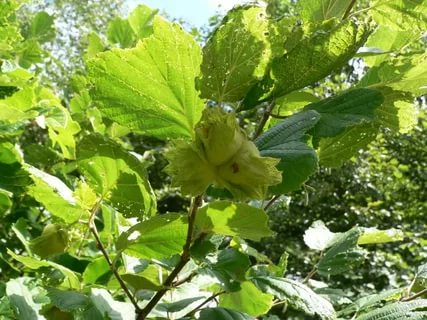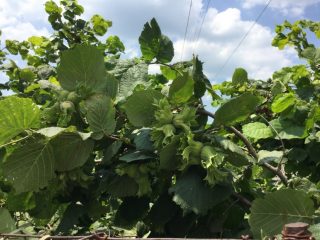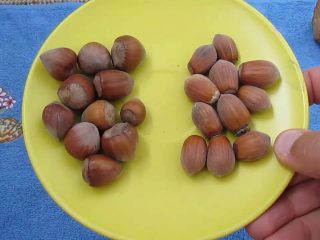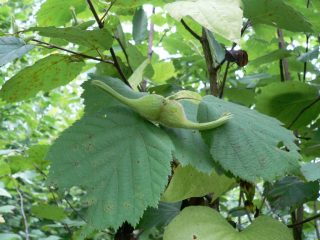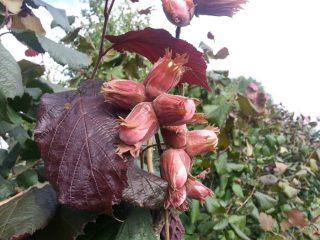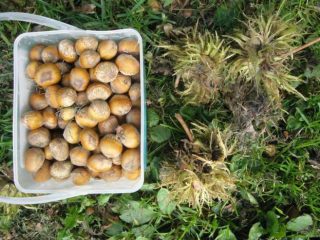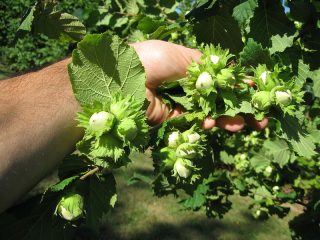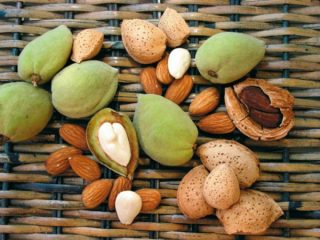Content
Various-leaved hazel bears tasty and healthy fruits, which explains its great popularity among summer residents. The plant looks attractive, easy to care for and gives good yields. Hazel reproduces easily, so there will be no shortage of planting material.
Description of variegated hazel
Hazel-leaved shrub - a variety of hazel, belongs to the Birch family. The plant is of medium vigor, outwardly very similar to hazelnuts. An adult bush does not exceed 4-5 m.
Young bushes are well leafy, with age, the crown thins. The leaf plate is oval, wide, pointed at the end. Its length reaches 11 cm. The outer side of the leaf is dark green, and the inner side is somewhat lighter.
The shrub begins to bloom in early spring, and catkins appear in mid-April. Ripe nuts are harvested at the end of September.
In its natural habitat, the shrub is found in the Far East, Siberia, East Asia. The frost resistance of the species is good, the trees painlessly tolerate a drop in temperature to -40 ° C. If the flowering period coincides with recurrent frosts, then the flower buds can easily withstand up to -8 ° C, while the pollen does not suffer at all. However, the tops of the branches can freeze if the shrub is planted in the wrong place.
Fruiting of the bush begins early. Already a 3-year-old seedling will give a little crop. Its average life span is 80 years. The fruits of variegated hazel are small nuts, no more than 1.5 cm in diameter. At the beginning of formation, they are densely covered with green bell-shaped leaves. As they ripen, the nuts turn dark brown. The shell is strong, so the fruit does not crack on the branches. Ripe nuts fall off easily.
Planting and caring for variegated hazel
In order for the shrub to develop correctly, you need to choose a suitable place and planting time for it. After all, the amount of the harvested crop will depend on this. Caring for variegated hazel does not take much time and does not cause trouble.
Preparation of planting material and site
The variegated hazel does not tolerate sunny places. The abundance of bright rays reduces productivity, young leaves are baked and curled. In its natural environment, the tree grows in shady forests, undergrowth. However, heavily shaded areas are not suitable. The ideal conditions for growing a shrub is a thin shade.
The soil on the site should be rich in humus and other organic matter, moderately moist. Landing in wetlands is not carried out. The groundwater level for hazel is at least 1.5 m.
Before planting hazel, the soil is prepared in advance. If necessary, it is flavored with leaf litter, matured compost and dug up.
You can plant variegated hazel both in spring and autumn. It depends on the personal preference of the grower and the growing region. Spring plantings need more care.
For planting, hazel seedlings are prepared in advance. The roots are shortened to a length of 25 cm. The shoots are cut by a third. If the root system has dried up during transportation, then it is better to soak it in a bucket of water. The procedure is carried out one day before the upcoming landing.
Landing rules
Hazel is planted separately from other trees. The distance between them should not be less than 5 m. The planting pit is prepared in a month. Its width does not exceed the root system, its depth is up to 50 cm.For the normal development of the seedling, the pit should be filled with fertilizers:
- manure;
- humus;
- mineral complex of phosphorus-potassium mixtures;
- leafy land.
The top layer of soil is mixed with fertilizers, the bottom of the pit is well drained with improvised means, after which the soil mixture is laid. The well prepared in this way is watered abundantly, covered with foil and left for a month for the earth to settle.
Watering and feeding
Various-leaved hazel needs regular watering and fertilizing so that the plant can fully bloom and bear fruit. The soil under the bush is moistened 6 times a season if the weather is hot. At the same time, the watering rate is at least 60 liters per plant. If it rains regularly, then watering is reduced so that the root system does not suffer from waterlogging.
You need to feed the plant in spring and autumn. At the beginning of the growing season, hazel needs more nitrogenous fertilizers to grow enough green mass. In the fall, it is advisable to switch to top dressing, in which phosphorus and potassium prevail. Experienced gardeners recommend regularly applying humus and manure. Moreover, such fertilizers are preferable for young plants, the nuts will ripen together.
Trimming and shaping
The bushes of variegated hazel do not need regular pruning. A well-developed plant should have at least 6-10 strong shoots. It is enough to shorten young branches a little every season, to remove dry or thickening shoots.
If hazel is grown in the form of a tree, then you need to take care of it a little differently:
- regularly remove the lower branches on the trunk;
- form a bowl-shaped crown so that it is convenient to collect nuts;
- cut off shoots in spring and autumn.
During spring pruning, dry and poorly overwintered shoots are removed, the ends of the branches are slightly shortened, stimulating growth. More radical pruning is done in the fall. To do this, cut out all the shoots that thicken the crown, cut the rest by 1/3.
Preparing for winter
An adult plant overwinters without additional shelter. It is enough to dig the soil around it well to reduce the likelihood of pest infestation and carry out moisture-charging late autumn watering.
It is better to insulate young trees additionally so that they can withstand the drop in temperature well. The trunk is well spud, covered with dry foliage and wrapped with covering material. In the spring, the shelter is removed gradually.
The harvest
The productivity of variegated hazel is periodic. The tree bears fruit stably for 2-3 years, after which there is a dormant period. The amount of harvest is declining or not at all.
In variegated hazel, cross-pollination, so you can increase the yield by planting several plants at a distance of 3-4 m from each other.
Reproduction
Various-leaved hazel reproduces in several ways, but not all of them are suitable for home use and give good results:
- Seed reproduction - a long process, the first harvest appears after 8-10 years. Parental qualities are not preserved in this case.
- Wild walnut grafting - the method allows you to get a varietal tree that will bear fruit well. It is possible to inoculate by copulation method, in splitting. The best time is the end of summer.
- Division of an adult bush - the fastest way, which fully preserves the maternal qualities of the plant. Fruiting of hazel will begin early.
- Rejection method - an effective way when you need to quickly get a high-quality seedling.Shoots from the bottom of the bush are pinned to the ground and the next year they give roots. You can propagate in this way in spring and autumn.
- Planting root suckers - the method is suitable for beginner gardeners. A young plant will begin to bear fruit in a few years. Maternal qualities are preserved completely.
If you need to get a large number of variegated hazel seedlings, then you can try to cut a bush. To do this, young shoots are cut in the fall, planted in closed ground, and in the spring they are transferred to a permanent place in the garden.
Diseases and pests
Various-leaved hazel has an average resistance to diseases and pests. In a rainy autumn, the plant is affected by fungal diseases:
- powdery mildew;
- leaf spot;
- diplodiosis.
To avoid damage, the shrub must be regularly cleaned of dry branches, treated wounds and cracks on the trunk with copper sulfate and whitewashed. The crown is sprayed with a solution of Bordeaux liquid at the beginning of the growing season and after harvesting.
The most important pests of variegated hazel:
- weevil;
- moth;
- volnyanka.
These insects feed on the green parts of the tree, penetrate the kernels and can destroy most of the crop. To prevent this from happening, you need to conduct a comprehensive fight to destroy pests. In addition to timely processing of the tree, you need to regularly shake off the larvae and destroy them, dig up the trunk circle, clean it of weeds, and burn worm nuts.
You can notice the appearance of pests by the twisted leaves of variegated hazel. As the larvae develop, the leaves dry, the growth of the tree stops, holes and stripes appear on the leaf plate. Leaf fall begins early.
Conclusion
Various-leaved hazel is suitable for growing on an industrial scale and for hobbyists. The shrub does not need a kind of care, it takes root well in the conditions of Russia, and gives a bountiful harvest.
